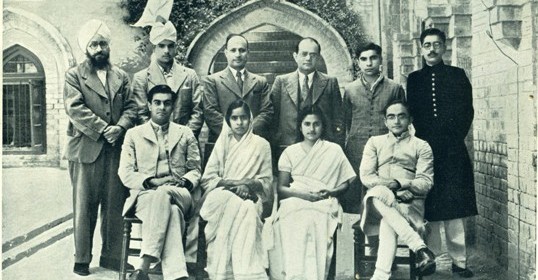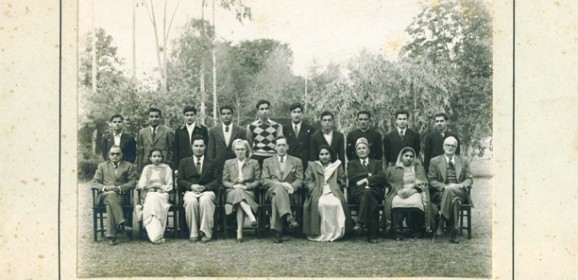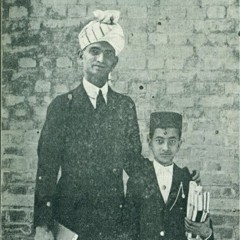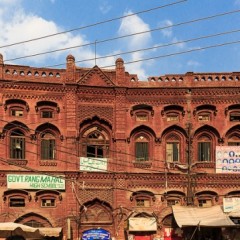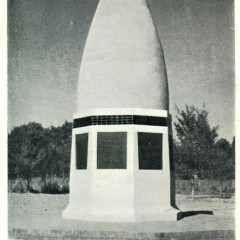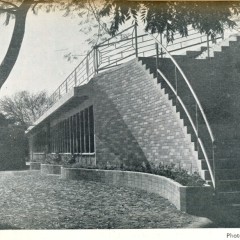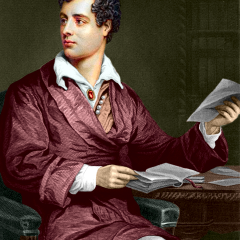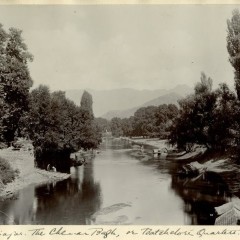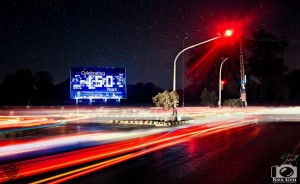The Long and Short of It
In an irreverent 1917 publication by students of FCC, the photograph (and title) above had the following caption: “On the right a student of the First Year Class; on the left a student of the Sixth Year (M.A.) Class. The contrast illustrates the remarkable physical development which accompanies the mental culture which F. C. C. gives her students.” Image and text: Pictorial Number of the Forman Christian College Monthly, August, 1917. Published by Rev R L Wilson, Forman Christian College, Lahore. Printed by Edwin Haward at The Civil and Military Gazette Press. While the photographer has not been named for this photograph, the final page of the publication states: “The Editors gratefully acknowledge their obligation to Mr. Ferger for the majority of the pictures herein...
Historical Sketch
The Forman Christian College is an aided institution, preparing students for degrees in Arts and Sciences of the Punjab University. It is under the care of, and supported by, the Ludhiana Mission, of the American Presbyterian Church, United States of America, and is controlled by a Board of Trustees appointed by that Mission. It was formerly called the Lahore Mission College, but in November, 1894, by an action of the Ludhiana Mission this name was changed to that of “The Forman Christian College”. Dr. Forman’s actual connection with the College covers a period of only a few years, yet his work was the necessary preparation for the enterprise and forms the foundation on which it will ever rest. Any sketch of the history of the Forman Christian College would be incomplete without a reference to the older institution, the Mission School, out of which it grew, and with which its early history is interwoven. First Beginnings. On December 19th, 1849, the Rev. C. W. Forman, D. D., opened a small School near the Bhati Gate. It was the first A. V. [Anglo Vernacular i.e. English medium] institution in Lahore, and indeed the first North of the Beas. It began with only three boys, for there was little desire for education among Panjabis in those days, and the first pupils had to be paid to induce them to come to school. But the people soon began to see where their interests lay, and under Dr. Forman’s wise and able management the school rapidly grew, until after a period of 20 years there were some 1,600 pupils reading in the Rang Mahal and in Branches connected with it. It was now felt by Dr. Forman that the time had come for completing his educational system by the establishment of a College Department. Accordingly, Collegiate classes were opened by him in 1864, and, on his departure to America, the Rev. Alexander Henry, M. A. became the Principal of the new institution, while the Rev. W. J. P. Morrison occupied the chair of English Language and Literature. The College enjoyed a brief but prosperous existence. Within the four years that it remained in operation it was successful in passing the following Graduates and Under-Graduates at the Calcutta University Examinations:- GRADUATES. G. S. Lewis, Esq., Extra Judicial Assistant Commissioner, Amballa. Lala Thakur Das, Assistant Inspector of Schools, Rawalpindi. (Died 1890.) UNDER-GRADUATES. — (F. A.) Jacob Basten, Esq., Head Master, M. B. School, Jullunder. Pandit Prem Nath, Examiner of Accounts, P. W. D., Punjab. Lala Sulakhan Mall, Accountant, P. W. Department. Lala Dina Nath, Munsiff, Jullunder District. In 1868, owing to Mr. Henry’s sudden...
Unveiling of Memorial Pillar at New Site 1936
After luncheon at the new site [the current campus], on December the 20th, 1936, Dr. S. K. Dutta conducted the gathering to the Memorial Pillar, where it stood like a gigantic finger pointing to the heaven, a silent testimony to the selfless work of Dr. C. W. Forman, the Founder of this College, and his successors. The Principal guided the company and, stopping at each tablet, read out its contents. On the first tablet was a history of the College and the date of its foundation and of the erection of the Pillar. The next tablet contained a list of five names – mere names and no more. But names that mean much to every Formanite – Dr. C. W. Forman, the Founder of this College, Dr. H.C. Velte, Sir James Ewing, Dr H.D. Griswold, Dr. J. H. Orbison, all of whom occupy a definite niche in the fifty years of existence of the Forman Christian College. The third tablet again contained names and no more. But each of these names signifies the progressive evolution of this College, as it advanced step by step, from a College with fifteen students to a College now containing over one thousand students. Forman, Ewing, Lucas, Dutta – all stepping-stones in the progress of the College; significant of what the College was and what it will be. With the erection of this Memorial Pillar we ring down the curtain over the fifty years of service of this College. M. C. Sanyal (Assistant Editor, The Folio, FCC Magazine, 1936-37) Source of text and image: The Folio, FCC Magazine, Vol. XXVIII, January 1937 to February 1937. Notes: Dr Sufian Aslam (FCC 1968-1972), Dean of Sciences, remembers seeing this monument when he was a student at FCC. It was on the land which currently has the PCSIR buildings. The monument was pulled down when the boundary wall was...
The Student Centre 1963
The structure nearing completion (as of February, 1963) in the physical education sector of the Forman Christian College campus has the distinction of having been praised and condemned already in the strongest terms possible by the large number of amateur critics who have observed the growth of the building. Adverse reactions go so far as to compare it with a third class waiting hall or a stable. Favourable comments are inclined to reflect as unrestrained a response on the other side. It would be safe to say, at the least, that the appearance of the building has not passed unnoticed. The concept of the Lucas Student Centre originated in the Report of the Commission on National Education with its emphasis on the need for developing facilities for students on a larger scale than hitherto existed. The willingness of the Government of Pakistan to make funds available made it possible to bring this multipurpose building into existence, while the creative planning and design of the Engineering Department of the United Christian Hospital, under the guidance of its head, Mr. Le Young, gave form to the vaguely conceived ideas of the college planners. The movement from concept to completion is almost finished. Mr. Young has designed a building that provides the Physical Education Department with an outdoor gymnasium, playing court, shower and locker rooms and an office. Part of the building houses community service facilities, such as barbering, tailoring, cycle repairing and a book and stationery shop. Refreshment rooms will be confined to a tea shop and fruit shop for the present, although further expansion is possible which would include a full cafeteria system dining room and kitchen. Student and staff lounges and further office space are included. Finally, the roof has been designed as a tiered stadium for both the athletic playing field in front of the Centre and the enclosed gymnasium within. Lighting has been provided for night games and functions. The design of the Centre is a major point of controversy. The person who has seen the building may be somewhat startled by the claim that the design does conform to the standard set by Mughal architecture and follows some of its major principles, if these are accepted as consisting of a sense of austerity, formality, balance, colour and, finally, the architectural value of sincerity. With respect to the first two characteristics, the building clearly suggests a formal and austere design. The long straight line and the severe 90° angle dominate the structure. Balance is achieved in a manner quite different from that used by the Mughals. Shahjahan thought of balance as symmetry; in the Student Centre balance...
Lord Byron’s Lost Letter
In the last Will and Testament of the late Rev. W. J. P. Morrison, M. A., it was provided that three hundred volumes of his library should be given to the F. C. College. For the purpose of making a selection of these books, we [Dr. Griswold et. al.] went to Dehra [Dun], on the 17th ultimo, and spent an entire day in choosing from some two thousand volumes, the three hundred best suited to our needs. These will soon be on our shelves and will constitute a very valuable addition to our Library. Among the books referred to is a copy of Byron’s complete works published in 1826. At sight of this old volume the archaeological instincts of our companion were stirred and he proceeded to glance through the book, when he was rewarded by discovering, pasted within the front cover, an autograph letter of Lord Byron, written from Venice on April 27th, 1819. How the letter came to be placed within that book, and through whose hands the treasure may have passed during the years since it was written, we shall probably never know. The letter is in a good state of preservation, and its contents consist of a very sprightly protest upon the part of the poet, against a statement which been made to the effect that he was the author of a certain book and had lived in a certain place. We here give it in full: Sir, In various numbers of your journal I have seen mentioned a work entitled “The Vampire” with the addition of my name as that of the author. I am not the author, and never heard of the work in question until now. In a more recent paper I perceive a formal annunciation of “The Vampire,” with the addition of an account of my “residence in the Island of Mitylene,” an Island which I have occasionally sailed by in the course of travelling some years ago through the Levant, and where I should have no objection to reside, but where I have never yet resided. Neither of these performances are mine, and I presume that it is neither unjust nor ungracious to request that you will favour me by contradicting the advertisement to which I allude. If the book is clever it would be base to deprive the real writer, whoever he may be, of his honours; and if stupid, I desire the responsibility of nobody’s dulness [sic] but my own. You will excuse the trouble I give you; the imputation is of no great importance, —and as long as it was confined to surmises and reports—I should have received it...
Prof Benade’s Wedding 1922
Mr. and Mrs. P. H. Benade of Donaghy Avenue [Big Run, Pennsylvania] have received a letter from India, telling of the marriage of their son, James Martin Benade to Miss Miriam McGaw, both of whom are doing missionary work under the Presbyterian Board of Missions. The letter describes the ceremony as follows: James Martin Benade and Miss Miriam McGaw, teacher in Mary Wanamaker High School at Allahabad, were united in marriage on June 27th, 1922, at Srinagar, Kashmere. The ceremony was performed under a huge old chinar tree, the decorations being cattails and pink dahlias with glossy green lotus leaves forming a semi-circle under the tree. Small tea tables and chairs were placed inside and a path from the tent to the circle was bordered with lotus leaves. The bride carried a bouquet of lotus blossoms. Rev. A. G. McGaw, father of the bride, performed the ceremony. Delicious refreshments were served to the many guests and pictures were taken. After spending their honeymoon in Kashmere, they will be at home at the The Abbey, Napier Road, Lahore, India. Mr Benade is a graduate of Grove City College and Princeton University and is head of the department of Physics of the Forman College at Lahore. The bride, who is the daughter of Dr. and Mrs. A. G. McGaw Presbyterian missionaries, was educated at Wooster College. Mr. and Mrs. Benade will remain in India until 1926. Text: Big Run Tribune, 1922. Copied from the original by F Raihan, 1958. Image: “View of Srinagar, Kashmir – Circa 1900” courtesy of...

